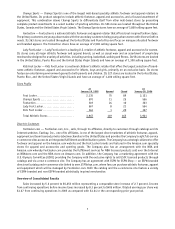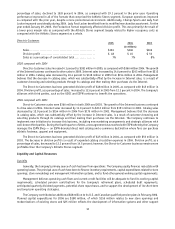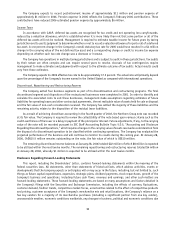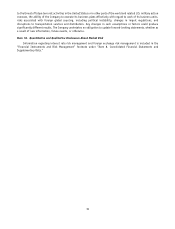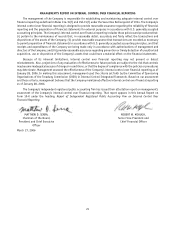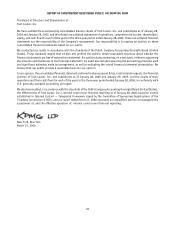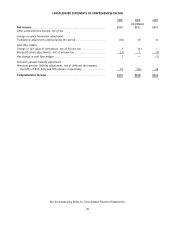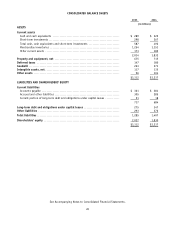Foot Locker 2005 Annual Report Download - page 33
Download and view the complete annual report
Please find page 33 of the 2005 Foot Locker annual report below. You can navigate through the pages in the report by either clicking on the pages listed below, or by using the keyword search tool below to find specific information within the annual report.
Impairment of Long-Lived Assets
In accordance with SFAS No. 144, the Company recognizes an impairment loss when circumstances indicate that the
carrying value of long-lived tangible and intangible assets with finite lives may not be recoverable. Management’s policy
in determining whether an impairment indicator exists, a triggering event, comprises measurable operating performance
criteria as well as qualitative measures. If an analysis is necessitated by the occurrence of a triggering event, the Company
uses assumptions, which are predominately identified from the Company’s three-year strategic plans, in determining the
impairment amount. The calculation of fair value of long-lived assets is based on estimated expected discounted future cash
flows by store, which is generally measured by discounting the expected future cash flows at the Company’s weighted-average
cost of capital. Management believes its policy is reasonable and is consistently applied. Future expected cash flows are based
upon estimates that, if not achieved, may result in significantly different results. Long-lived tangible assets and intangible
assets with finite lives primarily include property and equipment and intangible lease acquisition costs.
The Company is required to perform an impairment review of its goodwill, at least annually. The Company has chosen
to perform this review at the beginning of each fiscal year, and it is done in a two-step approach. The initial step requires
that the carrying value of each reporting unit be compared with its estimated fair value. The second step — to evaluate
goodwill of a reporting unit for impairment — is only required if the carrying value of that reporting unit exceeds its
estimated fair value. The fair value of each of the Company’s reporting units exceeded its carrying value as of the beginning
of the year. The Company used a combination of a discounted cash flow approach and market-based approach to determine
the fair value of a reporting unit. The latter requires judgment and uses one or more methods to compare the reporting
unit with similar businesses, business ownership interests or securities that have been sold.
Pension and Postretirement Liabilities
The Company determines its obligations for pension and postretirement liabilities based upon assumptions related
to discount rates, expected long-term rates of return on invested plan assets, salary increases, age and mortality among
others. Management reviews all assumptions annually with its independent actuaries, taking into consideration existing
and future economic conditions and the Company’s intentions with regard to the plans. Management believes that its
estimates for 2005, as disclosed in “Item 8. Consolidated Financial Statements and Supplementary Data,” to be reasonable.
The expected long-term rate of return on invested plan assets is a component of pension expense and the rate is based
on the plans’ weighted-average target asset allocation of 64 percent equity securities and 36 percent fixed income
investments, as well as historical and future expected performance of those assets. The target asset allocation is selected
to obtain an investment return that is sufficient to cover the expected benefit payments based on the timing of settlements
and to reduce future contributions by the Company. The Company’s common stock represented approximately 2 percent
of the total pension plans’ assets at January 28, 2006. A decrease of 50 basis points in the weighted-average expected
long-term rate of return would have increased 2005 pension expense by approximately $3 million. The actual return on
plan assets in a given year may differ from the expected long-term rate of return and the resulting gain or loss is deferred
and amortized into the plans’ performance over time. An assumed discount rate is used to measure the present value of
future cash flow obligations of the plans and the interest cost component of pension expense and postretirement income.
The discount rate selected to measure the present value of the Company’s benefit obligations as of January 28, 2006 was
derived using a cash flow matching method whereby the Company compares the plans’ projected payment obligations by
year with the corresponding yield on the Citibank Pension Discount Curve. The cash flows are then discounted to their
present value and an overall discount rate is determined. A decrease of 50 basis points in the weighted-average discount
rate would have increased the accumulated benefit obligation as of January 28, 2006 of the pension plan by approximately
$30 million and the effect on the postretirement plan would not be significant. Such a decrease would not have
significantly changed 2005 pension expense or postretirement income. There is limited risk to the Company for increases
in healthcare costs related to the postretirement plan as new retirees have assumed the full expected costs and existing
retirees have assumed all increases in such costs since the beginning of 2001. The additional minimum liability included
in shareholders’ equity at January 28, 2006 for the pension plans represented the amount by which the accumulated
benefit obligation exceeded the fair market value of the plan assets. During 2005, the Company contributed $19 million
to the U.S. qualified pension plan and in February 2006 contributed an additional $51 million, these contributions were
in advance of ERISA requirements. Also during 2005, the Company contributed $7 million to the Canadian qualified pension
plan and in February 2006 contributed an additional $17 million.
17


